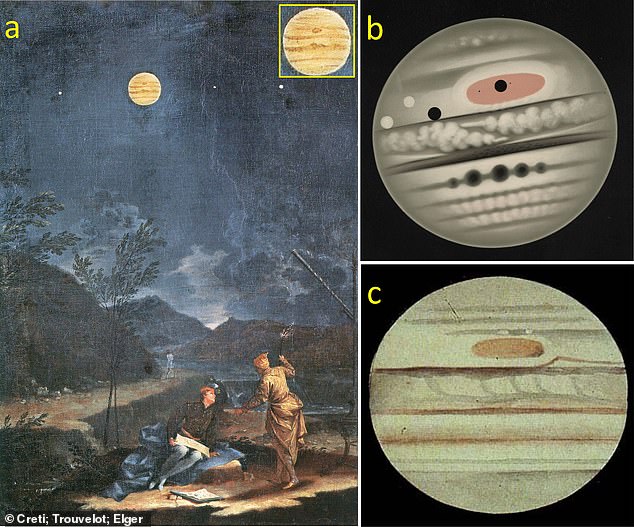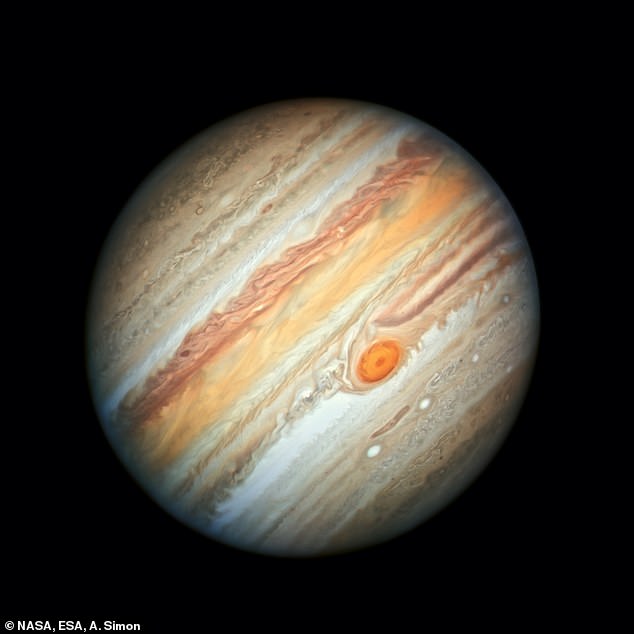True age of Jupiter’s Great Red Spot REVEALED – and it’s younger than the United States
Scientists have determined the true age of Jupiter’s Great Red Spot, showing that the storm system is younger than that of the US.
The massive swirling storm system was originally thought to have been discovered in 1665 by astronomer Giovanni Domenico Cassini, but a new study found it was not the most recent site.
That means the Great Red Spot is about 190 years old since it was last documented in 1831.
Researchers from Spain also found that the storm system is getting smaller every year, from 40,000 km wide when it was observed in 1879 to just 13,000 km wide now – suggesting it could one day disappear too.
Researchers found that Jupiter’s Great Red Spot is younger than the US and is 190 years old. However, it is still the oldest vortex that exists in our solar system
Researchers looked at early observations dating back to Cassini’s discovery, including his drawing of the celestial event, and used computer models to reveal the age of the site and how it came to be.
Cassini first observed the Great Red Spot in the 17th century and dubbed it the “Permanent Spot,” which persisted until 1713 when astronomers could no longer find it.
More than 100 years later, astronomers observed a similar storm in the same region, leading them to wonder whether it was the “permanent spot” or another storm that happened to form in the same location.
“From the size and motion measurements, we concluded that it is highly unlikely that today’s Great Red Spot was the ‘Permanent Spot’ observed by Cassini,” said Agustín Sánchez-Lavega, lead author of the study and planetary scientist at the University of the Basque Country in Bilbao, Spain.
“The ‘Permanent Spot’ probably disappeared sometime between the mid-18th and 19th centuries, in which case we can now say that the lifespan of the Red Spot is more than 190 years,” he added.

Researchers looked at early observations dating back to Cassini’s discovery, including his drawing of the celestial event, and used computer models to reveal the age of the site and how it materialized.
NASA’s Juno spacecraft has been orbiting Jupiter since 2016 and captured images of the site showing it to be shallow and thin.
The data suggested it formed from a giant superstorm, like the one on Saturn.
Caught between two jet streams, the Great Red Spot is an anticyclone swirling around a center of high atmospheric pressure caused by a superstorm that forces it to spin in the opposite direction to Earth’s hurricanes, creating an anticyclone.

Researchers believe the original Great Red Spot observed by Cassini disappeared in the mid-18th or 19th century
The strong wind at the site stirs up chemicals such as ammonia ice particles in the top layer, giving it a red tint when exposed to the sun’s rays.
More research needs to be done to understand why the Great Red Spot is shrinking over time and to further understand how it has remained in the same location for almost two centuries.
Scientists ultimately hope to understand whether the spot will disintegrate and disappear once it shrinks to a certain size, or whether it will reach a point where it is stable, allowing it to persist for decades to come.
‘It was very motivating and inspiring to look at the notes and drawings of Jupiter and its permanent location made by the great astronomer Giovanni Domenico Cassini, and at his articles from the second half of the 17th century describing the phenomenon,’ Sánchez-Lavega said.
‘Others before us had investigated these observations and now we have quantified the results.’
